Week 1: October 31 – November 6, 2005
|
|
| THIS WEEK | THIS WINTER | 2005 TOTAL | SITE TOTAL | |
|---|---|---|---|---|
| # birds (and species) banded | 56 (10) | 56 (10) | 4015 (84) | 4936 (92) |
| # birds (and species) repeat | 26 (5) | 26 (5) | 767 (36) | 845 (41) |
| # birds (and species) return | 1 (1) | 1 (1) | 73 (14) | 73 (14) |
| # species observed | 28 | 28 | 163 | 169 |
| # net hours | 26.0 | 26.0 | 5407.1 | 6381.6 |
| # birds banded / 100 net hours | 215.4 | 215.4 | 74.3 | 77.3 |
Note: table does not include nocturnal banding (owls)
Bander-in-charge: Marcel Gahbauer Assistants: Shawn Craik, Lena Douris, Barbara Frei, Marie-Anne Hudson
Notes: Our first week of the 2005/06 winter season was much quieter than the pace we have become accustomed to over the past three months of migration monitoring, but was productive nonetheless. In just two half-mornings of banding, we caught over 50 new birds, bringing us to just over 4000 for the year, and we managed to add another new species to the MBO checklist.
With all but the hardiest of migrants now having left the area, the number of species seen this week dropped considerably to just 28. Most of these are species which were present throughout last winter, but there were some notable exceptions, including Wood Duck, Fox Sparrow, and Red-winged Blackbird, all of which are likely to move on before much longer. The weekly total also benefited from a nice raptor migration on Wednesday morning, featuring all three accipiter species, and at long last MBO’s first Golden Eagle, being blown past us on a strong northwest tailwind.
Among the ten species banded this week, the dominant birds were American Goldfinch (23) and Slate-coloured Junco (18), together accounting for almost three-quarters of individuals banded. The two Mourning Doves caught on Wednesday were the first ones banded at MBO since late last winter – they seem to be good at avoiding the nets during migration monitoring, but can’t resist the lure of the feeders!
This is our second year of winter population monitoring, and we are hoping to achieve more even coverage than last year, thanks to being better prepared for the challenges of winter banding. Again we are hoping to track the fluctuations in species numbers through the season, especially for the ‘winter finches’ which are more nomadic than most others. Also, we expect to be recording ‘returns’ of individuals we banded here last winter. Already in the past two weeks we have had returns of Black-capped Chickadee, Northern Cardinal, and Slate-coloured Junco banded here last November or December. The Junco is the most interesting of these, as it does not breed in this area, and therefore has migrated elsewhere for the breeding season, yet returned here for winter – a demonstration of site fidelity we would not have expected. It will be interesting to see whether this individual stays here through the winter again, or migrates further this time, as adult Juncos tend to do.
Week 2: November 7-13, 2005
In our experience at MBO, American Goldfinches tend to be remarkably consistent in weight – often 13 grams, and almost always within the range of 12-14 grams. However, this after-hatch-year male weighed in at a whopping 16 grams, despite carrying little visible fat. Many species show variation in size across their range, and the American Goldfinch is no exception. The pallida subspecies, which breeds from northwestern Ontario to interior British Columbia, tends to be larger than the tristis subspecies native to the northeast. A northwest to southeast migration is common in a variety of passerines, and so it is quite possible that this was a western goldfinch moving through our area. (Photo by Marcel Gahbauer)
|
|
| THIS WEEK | THIS WINTER | 2005 TOTAL | SITE TOTAL | |
|---|---|---|---|---|
| # birds (and species) banded | 23 (3) | 79 (10) | 4038 (84) | 4959 (92) |
| # birds (and species) repeat | 11 (2) | 37 (5) | 778 (36) | 856 (41) |
| # birds (and species) return | 1 (1) | 1 (2) | 74 (14) | 74 (14) |
| # species observed | 26 | 32 | 163 | 169 |
| # net hours | 12.0 | 38.0 | 5419.1 | 6393.6 |
| # birds banded / 100 net hours | 191.7 | 207.9 | 74.5 | 77.5 |
Note: table does not include nocturnal banding (owls).
Bander-in-charge: Marcel Gahbauer Assistants: Barbara Frei, Robert Oligny
Notes: As we approach mid-November, the bird community is taking on an increasingly typical winter feel. On each of three outings this week we failed to crack the 20-species barrier, a mark which we wouldn’t have even given a second thought just a couple of weeks ago. Fox Sparrows and Golden-crowned Kinglets are among the few remaining late fall migrants in the area.
Four new species for the season were recorded this week. Hairy Woodpecker and White-breasted Nuthatch were fully expected, but a female Mallard in the back pond and a Brown-headed Cowbird near Stoneycroft Pond were somewhat surprising.
For the most part it was an alternatingly windy and wet week, and we only were able to get in one banding session, on Friday morning. Even then it was windier than we would have liked, but we nonetheless caught a good number of American Goldfinches, Slate-coloured Juncos, and Black-capped Chickadees. The latter appear to still be migrating, as many of them were unbanded, though hanging out with some of the older individuals we banded here last winter.
Though we didn’t realize it at the time, the last American Goldfinch banded on Friday (photo above) was the 5000th bird we have banded at MBO (including the 4965 birds from regular banding summarized in the table above, plus the 35 owls we have banded at night). Correction: upon checking our 2005 numbers, we were actually a few short of 5000 this week after all!
Week 3: November 14-20, 2005
|
|
| THIS WEEK | THIS WINTER | 2005 TOTAL | SITE TOTAL | |
|---|---|---|---|---|
| # birds (and species) banded | 37 (5) | 116 (10) | 4075 (84) | 4996 (92) |
| # birds (and species) repeat | 11 (2) | 48 (5) | 789 (36) | 867 (41) |
| # birds (and species) return | 1 (1) | 2 (3) | 75 (14) | 75 (14) |
| # species observed | 16 | 33 | 163 | 169 |
| # net hours | 5.0 | 43.0 | 5424.1 | 6398.6 |
| # birds banded / 100 net hours | 740.0 | 269.8 | 75.1 | 78.0 |
Note: table does not include nocturnal banding (owls).
Bander-in-charge: Marcel Gahbauer Assistants: Shawn Craik, Barbara Frei, Marie-Anne Hudson, Betsy McFarlane
Notes: As has been the norm of late, weather limited us to one morning of banding this week. Even then, an unexpected burst of flurries mid-morning caused us to cut it short, contributing to the astronomical rate of 740 birds per 100 net hours recorded for the day (having more than two dozen American Goldfinches hit the nets together makes a bigger impact than usual when the nets aren’t open long at all).
With today’s influx, the American Goldfinches have taken a commanding lead for the season – 64 out of a total of 116 birds banded! Interestingly, only two of the ones caught this week were banded in previous weeks, suggesting there is still a considerable migration underway. Most interesting was a third banded bird which didn’t correspond to any of the band series we have used at MBO – after more than a year, we have finally caught our first foreign-banded bird! We hope to learn about its origins next week.
Otherwise, the past week has been an unremarkable one. The only new species added to the list for this winter was Common Raven, while others such as Wood Duck and Golden-crowned Kinglet were absent and have likely left for the south.
Week 4: November 21-27, 2005
|
|
| THIS WEEK | THIS WINTER | 2005 TOTAL | SITE TOTAL | |
|---|---|---|---|---|
| # birds (and species) banded | 17 (4) | 133 (10) | 4092 (84) | 5013 (92) |
| # birds (and species) repeat | 18 (2) | 66 (5) | 807 (36) | 885 (41) |
| # birds (and species) return | — | 2 (3) | 75 (14) | 75 (14) |
| # species observed | 18 | 37 | 164 | 170 |
| # net hours | 8.5 | 51.5 | 5432.6 | 6407.1 |
| # birds banded / 100 net hours | 200.0 | 258.3 | 75.3 | 78.2 |
Note: table does not include nocturnal banding (owls).
Bander-in-charge: Marcel Gahbauer Assistants: Shawn Craik, Christina Donehower, Barbara Frei, Marie-Anne Hudson, Mike Mayerhofer, Betsy McFarlane, Mark O’Connor
Notes: Yet again it was an abnormally cold week for November, and as has been the pattern throughout the month, we had only one morning of banding. Having forgotten to take the nets in before the snow, we found one of them frozen shut; however, the other three were productive, with 35 birds caught in just under three hours.
To our surprise, we banded more Mourning Doves than any other species. Previously we had never caught more than two in a day, and only five in total over a period of 18 months. Over the past several weeks we have seen much higher numbers of Mourning Doves than ever before, likely attracted by the corn in the neighbouring field. Nonetheless, it was still quite a surprise to band six of them in one short morning.
Another peculiar note from our morning of banding involves the two Downy Woodpeckers we banded. Caught an hour apart at exactly the same point on net V4, both had the same age, sex, wing chord, fat, and weight!
The other highlight of the week was our long-anticipated first sighting of a Rough-legged Hawk. It flew northwest over Stoneycroft on Saturday morning while we were at the nets. It becomes the 170th species recorded since MBO was established in May 200
Week 5: November 28 – December 4, 2005
|
|
| THIS WEEK | THIS WINTER | 2005 TOTAL | SITE TOTAL | |
|---|---|---|---|---|
| # birds (and species) banded | 27 (4) | 160 (10) | 4119 (84) | 5040 (92) |
| # birds (and species) repeat | 24 (3) | 90 (5) | 831 (36) | 885 (41) |
| # birds (and species) return | 2 (1) | 5 (2) | 77 (14) | 75 (14) |
| # species observed | 23 | 41 | 164 | 170 |
| # net hours | 12.0 | 63.5 | 5444.6 | 6419.1 |
| # birds banded / 100 net hours | 225.0 | 252.0 | 75.7 | 78.4 |
Note: table does not include nocturnal banding (owls).
Bander-in-charge: Marcel Gahbauer Assistants: Shawn Craik, Barbara Frei, Marie-Anne Hudson
Notes: Overall, temperatures remained below normal for most of the week, but Wednesday and Thursday were quite mild and pleasant. On Wednesday, a new species for winter was spotted, a White-crowned Sparrow. The next morning, although the calendar turned to December, we had some other seasonal rarities, including a Great Blue Heron gliding in to the south end of Stoneycroft Pond, a male Red-winged Blackbird giving an odd call behind the cabin, a pair of Mallards erupting out of the back ponds as we walked past, and a pair of Common Mergansers flying along the far side of the corn field.
Banding this week took place only on Thursday, and was again very successful. For the first time in over two weeks, American Tree Sparrows were back in small numbers, and we banded a couple of them, along with a few of the many Juncos still hanging around. Once again though the Black-capped Chickadees and American Goldfinches dominated. We caught 25 chickadees, out of roughly 50 estimated in the area. Of these, many were recaptures of birds banded in the late part of the Fall Migration Monitoring Program, but several were originally banded in Fall 2004 or Winter 2004/05, including two individuals with consecutive band numbers that we last caught in February 2005! On the contrary, most of the goldfinches we are catching continue to be unbanded, indicating that either there is a very large flock in the area, or that the birds we are observing are late migrants.
Week 6: December 5-11, 2005
|
|
| THIS WEEK | THIS WINTER | 2005 TOTAL | SITE TOTAL | |
|---|---|---|---|---|
| # birds (and species) banded | 13 (4) | 173 (11) | 4132 (84) | 5053 (92) |
| # birds (and species) repeat | 8 (3) | 98 (5) | 839 (36) | 893 (41) |
| # birds (and species) return | 1 (1) | 6 (2) | 78 (14) | 78 (14) |
| # species observed | 17 | 43 | 164 | 170 |
| # net hours | 3.0 | 66.5 | 5447.6 | 6422.1 |
| # birds banded / 100 net hours | 433.3 | 260.2 | 75.8 | 78.6 |
Note: table does not include nocturnal banding (owls).
Bander-in-charge: Marcel Gahbauer Assistants: Shawn Craik, Gay Gruner, Marie-Anne Hudson, Mike Mayerhofer
Notes: Wednesday morning we went out for banding but it was unexpectedly cold and we were limited to observations; Sunday was expected to be a census-only day, but it ended up nice enough to allow for a bit of banding before the snow began to fall. The uncertainties of winter…
The bird of the week was a Rusty Blackbird discovered on the back loop of the census trail on Sunday morning, seeking out a melted trickle of water amidst the dusting of snow on the ground. It was later seen near the feeders, so it may stay around for a while. Also notable was an American Robin, and a surprisingly large (for this date) flock of 118 Canada Geese.
Among the birds banded, Black-capped Chickadees were again the most numerous. It may be that the large migration observed this fall is still not quite over. We also had a return of a Black-capped Chickadee last seen February 14 this year. Last week we recaptured two other chickadees banded that day and not seen since – it would be interesting to know where this little flock went in the interim, but we can only guess.
Week 7: December 12-18, 2005
|
|
Note: table does not include nocturnal banding (owls).
Bander-in-charge: Marcel Gahbauer Assistants: Shawn Craik
Notes: No banding this week, due to weather in combination with busy schedules in advance of the holidays. The highlights of the week were our first Red-breasted Nuthatch sighting of the winter, and increasing numbers of Common Redpolls, with as many as 6 by Thursday. On Friday, 41 cm of snow fell, the highest single day accumulation in over 30 years. It will be interesting to see whether this results in more birds concentrating at the feeders.
Week 8: December 19-25, 2005
|
|
Note: table does not include nocturnal banding (owls). Bander-in-charge: Marie-Anne Hudson Assistants: Shawn Craik, Helena Scheffer Notes: Three visits this week yielded some very interesting observations. On each occasion, a Rusty Blackbird was observed near the feeders, likely the same individual first spotted on December 11. It appears to favour the millet in the mix provided on the platform feeder. On Wednesday there was also a Red-winged Blackbird, and the first sighting of a White-throated Sparrow at the feeders since early November. The same day, a walk of the census loop produced the winter’s first Brown Creeper in the back woods. Aside from it, a few Black-capped Chickadees, and a flock of European Starlings, all other birds observed were in the vicinity of the feeders. No deer have been seen for many weeks, but now that there is snow cover, their tracks are visible and it is evident that they are using the site heavily, and in many cases following our trails. |
Week 9: December 26, 2005 – January 1, 2006
|
|
Note: table does not include nocturnal banding (owls). Bander-in-charge: Marcel Gahbauer Notes: A quieter week, with no repeat sightings of any of the “winter surprises” observed last week. Of note, however, was the flock of 19 Common Redpolls on Thursday, our highest count to date. At one point, 11 of them were on or immediately around the black nyjer seed tube, providing ample evidence that it is what is attracting them to the site. Also on Thursday, a couple of deer were heard down by the pond, crunching through the thick crust of ice on the snow. Their tracks are all over the place, and they are clearly sleeping under some of the conifers, but this is the first actual sighting in almost two months. First bird of the new year, seen on a Sunday walk, was a male Northern Cardinal right by the gate. The 2005 totals above summarize an excellent year of banding. However, we have every reason to expect that 2006 will be every bit as interesting again, and are looking forward to seeing what the changing seasons bring us once again. As of next week’s report, the year total counter will be reset, with today’s 7 species the first members of what will hopefully be another list of 160+ by the end of 2006. |
Week 10: January 2-8, 2006
|
Note: table does not include nocturnal banding (owls). Bander-in-charge: Marcel Gahbauer Assistant: Shawn Craik Notes: Three times this week we planned to put up the nets for a banding session, but each time the temperature was several degrees colder than forecast and we decided to err on the side of caution. However, at least some interesting observations were made during our visits. The Rusty Blackbird was back on Sunday, singing at length, and demonstrating a surprising boldness in going to the mixed seed feeder while we were standing only a few metres away. A bit later the same morning, we noticed that the Common Redpoll flock now numbers 28, and were impressed to see 12 of them hanging on the nyjer feeder at once. Also of note, a banded Red-breasted Nuthatch was seen near the feeders, likely the same individual banded during the early part of the 2005 Fall Migration Monitoring Program and seen sporadically since then. With milder temperatures forecast over the next week, we hope to be able to report on the first banding efforts of 2006 in next week’s report. |
Week 11: January 9-15, 2006
|
Note: table does not include nocturnal banding (owls). Bander-in-charge: Marcel Gahbauer Assistants: Shawn Craik, Keelan Jacobs, Greg Rand, Katleen Robert, Sandra Warren Notes: A warm spell gave us an opportunity to band twice this week, and we were amply rewarded for our efforts. The highlight was the opportunity to band “Blackie”, the male Rusty Blackbird that has been hanging around the feeders for the past month. He has shown great tolerance for our presence at the feeders when we refill them, often watching from the protective safety of the large hawthorn clump in the midst of the net array. True to form, he was well behaved in the hand while being banded. Also of note, we banded our first two Common Redpolls of the season on Thursday. We are recording the extent of pink on each individual according to the Redpoll Pink Code developed at Innis Point Bird Observatory. These first two birds had only the slightest hint of pink freckles on their cheeks, so we hope to put the code to more of a test when we catch some of the more colourful individuals we have seen at the feeders. Meanwhile, the most commonly banded species on each of our two outings was the Slate-coloured Junco, which seems to be overwintering in much larger numbers than last year. This week we had a considerably higher than usual proportion of returns, i.e. birds that we have not documented in over three months. For most of them, the period of absence was actually much longer than the prescribed minimum. A male House Sparrow banded on November 22, 2004 and not caught again until this Thursday set a new MBO record for longest period in between captures – just barely eclipsing the male American Goldfinch caught Friday, and last recorded December 4, 200 The goldfinch return is particularly interesting in that we see flocks of them come and go throughout the seasons, but this demonstrates that at least some individuals show fidelity to wintering grounds. For the first time in over a month, we were able to get the weekly total up to 20 species. This included our first Bohemian Waxwings of the winter, a flock of 11 flying toward the Arboretum on Friday, and our first sightings of Pileated Woodpecker, Cooper’s Hawk, and Red-winged Blackbird this year. The warm sunshine on Friday afternoon even coaxed a couple of Northern Cardinals and House Finches into song, and delivered our first insect sighting of the year (see photo below)!
Week 12: January 16-22, 2006
|
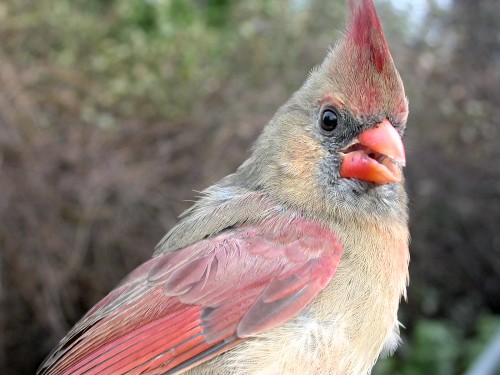 Northern Cardinals are among the ‘regulars’ at the feeders during the winter. This after-hatch-year female was banded at MBO in December 2004, and was not captured again until this week, back at the new feeder array. (Photo by Marcel Gahbauer)
Northern Cardinals are among the ‘regulars’ at the feeders during the winter. This after-hatch-year female was banded at MBO in December 2004, and was not captured again until this week, back at the new feeder array. (Photo by Marcel Gahbauer)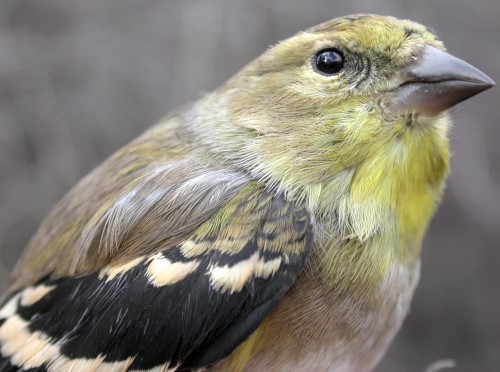
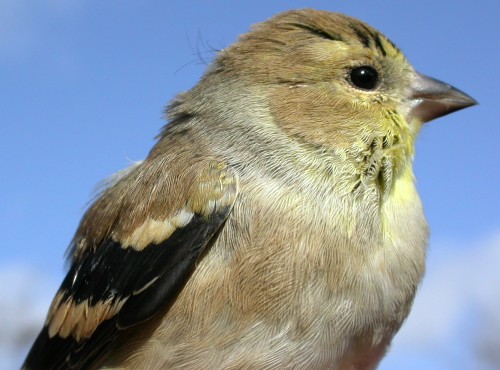 Yes, another American Goldfinch photo this week.
Yes, another American Goldfinch photo this week. 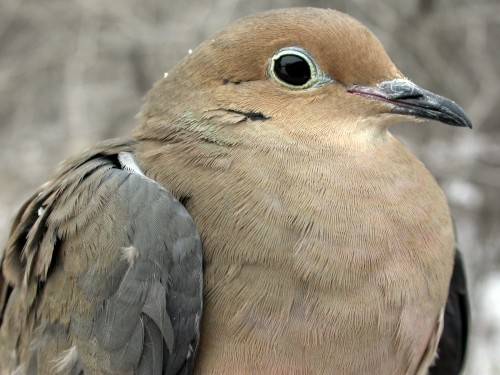 One of six Mourning Doves banded on November 26, a remarkable number considering that the cumulative total at MBO to date had been just five. (Photo by Marcel Gahbauer)
One of six Mourning Doves banded on November 26, a remarkable number considering that the cumulative total at MBO to date had been just five. (Photo by Marcel Gahbauer)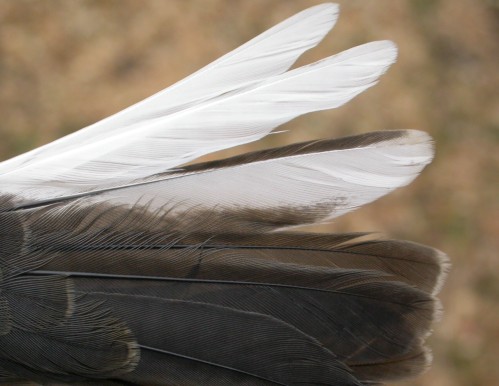 The tail of one of the Slate-coloured Juncos banded this week. The narrow and tapered shape of the outer rectrix is one of the factors used in identifying this as a hatch-year bird, in this case a male by body plumage and wing length. We have been recording the extent of white on the tail, classifying the amount of it on the outer three rectrices (r4 to r6). This individual shows an unusual pattern in that there is also a narrow white tip to all of the other tail feathers. (Photo by Marcel Gahbauer)
The tail of one of the Slate-coloured Juncos banded this week. The narrow and tapered shape of the outer rectrix is one of the factors used in identifying this as a hatch-year bird, in this case a male by body plumage and wing length. We have been recording the extent of white on the tail, classifying the amount of it on the outer three rectrices (r4 to r6). This individual shows an unusual pattern in that there is also a narrow white tip to all of the other tail feathers. (Photo by Marcel Gahbauer)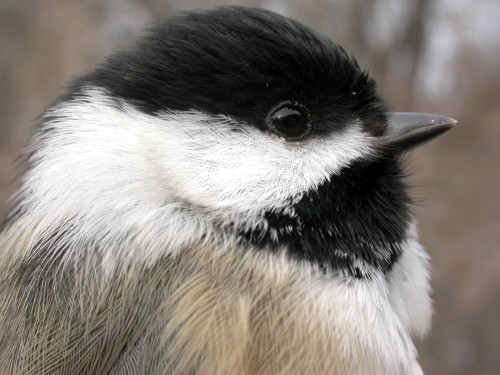 One of the Black-capped Chickadees banded this week, an adult that stopped pecking at fingers just long enough to allow this picture to be taken. (Photo by Marcel Gahbauer)
One of the Black-capped Chickadees banded this week, an adult that stopped pecking at fingers just long enough to allow this picture to be taken. (Photo by Marcel Gahbauer)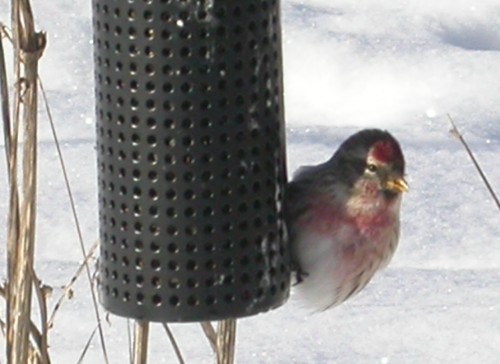 The Common Redpolls have begun to increase in numbers. This after-hatch-year male was remarkably tame, continuing to feed from the nyjer tube even when there was human activity only a few metres away. (Photo by Marcel Gahbauer) –
The Common Redpolls have begun to increase in numbers. This after-hatch-year male was remarkably tame, continuing to feed from the nyjer tube even when there was human activity only a few metres away. (Photo by Marcel Gahbauer) –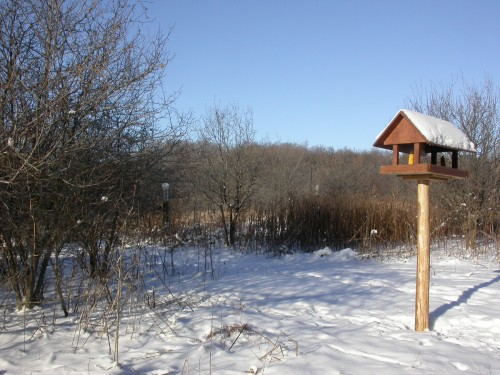 A wintry day at the feeders. (Photo by Marcel Gahbauer) –
A wintry day at the feeders. (Photo by Marcel Gahbauer) – Though not yet predictably present on a daily basis, the Common Redpolls are increasing in number, with as many as 19 observed together. In this photo, five of them are hanging on the new nyjer seed feeder, while a sixth one is flying in from the right, likely an after-hatch-year male based on the extensive rose wash on the upper breast. (Photo by Marcel Gahbauer) –
Though not yet predictably present on a daily basis, the Common Redpolls are increasing in number, with as many as 19 observed together. In this photo, five of them are hanging on the new nyjer seed feeder, while a sixth one is flying in from the right, likely an after-hatch-year male based on the extensive rose wash on the upper breast. (Photo by Marcel Gahbauer) –
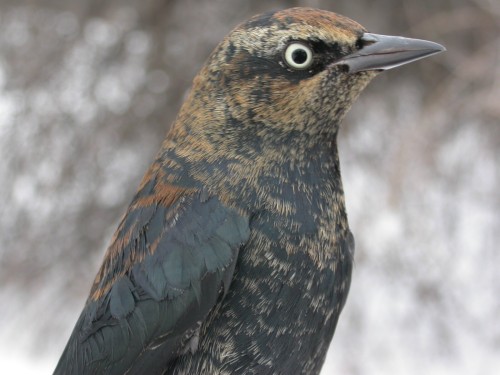
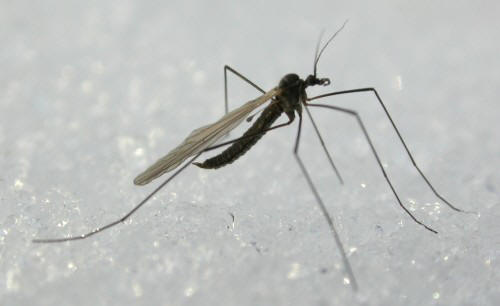 Insects of any kind are an unusual sight in Montreal in mid-January. This winter crane fly (family Trichoceridae) was out during the warm and sunny weather on Friday afternoon. (Photo by Marcel Gahbauer)
Insects of any kind are an unusual sight in Montreal in mid-January. This winter crane fly (family Trichoceridae) was out during the warm and sunny weather on Friday afternoon. (Photo by Marcel Gahbauer)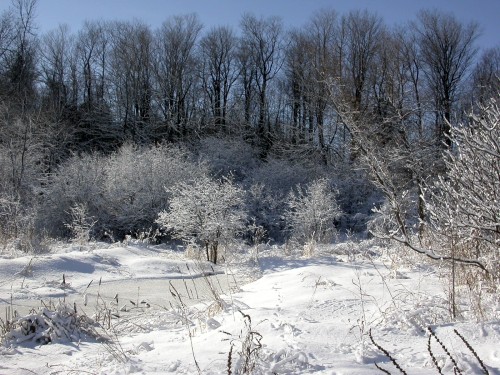 Rain some days, a winter wonderland on others – weather this week was highly variable. The nicest day was Sunday, when sunny skies lit up the fresh snow clinging to the branches of shrubs and small trees. The photo above, taken along the C nets, also illustrates the remarkably high water level in the ponds.
Rain some days, a winter wonderland on others – weather this week was highly variable. The nicest day was Sunday, when sunny skies lit up the fresh snow clinging to the branches of shrubs and small trees. The photo above, taken along the C nets, also illustrates the remarkably high water level in the ponds. Crows are not normally considered feeder birds, but on Sunday three of them were on the ground below the platform feeder and around the nearby mixed seed feeder, that suspiciously had been knocked to the ground. The crow in the photo above flew to the top of one of the adjacent conifers to watch while the feeders were replenished. (Photo by Marcel Gahbauer)
Crows are not normally considered feeder birds, but on Sunday three of them were on the ground below the platform feeder and around the nearby mixed seed feeder, that suspiciously had been knocked to the ground. The crow in the photo above flew to the top of one of the adjacent conifers to watch while the feeders were replenished. (Photo by Marcel Gahbauer)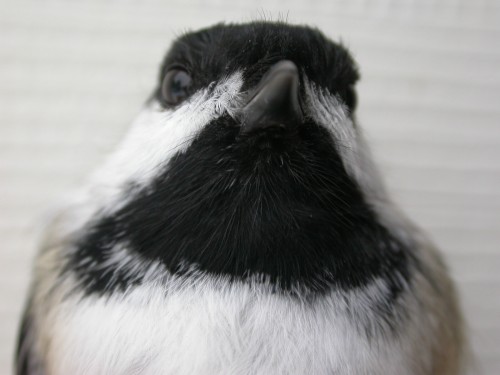 A mugshot of the first Black-capped Chickadee banded at MBO (Sept 19, 2004), and recaptured and photographed this week. The width and raggedness of the black bib may be indicative of age and/or sex; we have begun looking at this more closely with the intent of field-testing measures on individuals such as this with a known age and sex. (Photo by Marcel Gahbauer)-
A mugshot of the first Black-capped Chickadee banded at MBO (Sept 19, 2004), and recaptured and photographed this week. The width and raggedness of the black bib may be indicative of age and/or sex; we have begun looking at this more closely with the intent of field-testing measures on individuals such as this with a known age and sex. (Photo by Marcel Gahbauer)-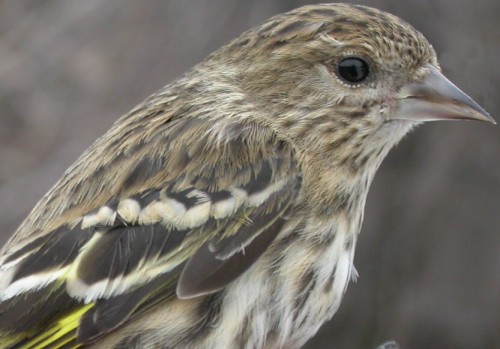 Pine Siskins were banded at MBO for the first time this week. (Photo by Marcel Gahbauer)-
Pine Siskins were banded at MBO for the first time this week. (Photo by Marcel Gahbauer)-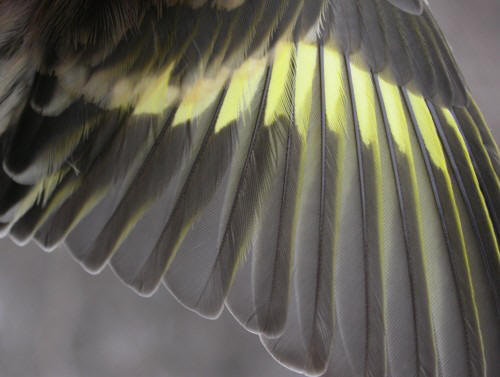 Though the range of variation remains poorly understood, the extent of yellow on the wing and tail of Pine Siskins is believed to serve as an indication of sex and age. The wing shown above had the greatest extent of yellow among the 7 Pine Siskins banded this week, and is believed to be that of an after-second-year male. (Photo by Marcel Gahbauer)
Though the range of variation remains poorly understood, the extent of yellow on the wing and tail of Pine Siskins is believed to serve as an indication of sex and age. The wing shown above had the greatest extent of yellow among the 7 Pine Siskins banded this week, and is believed to be that of an after-second-year male. (Photo by Marcel Gahbauer)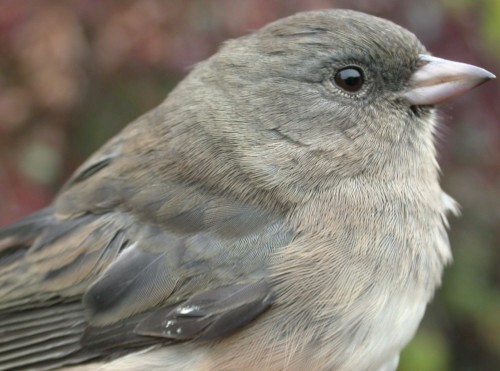 A hatch-year female Slate-coloured Junco made history for MBO this week – details below. (Photo by Marcel Gahbauer)-
A hatch-year female Slate-coloured Junco made history for MBO this week – details below. (Photo by Marcel Gahbauer)-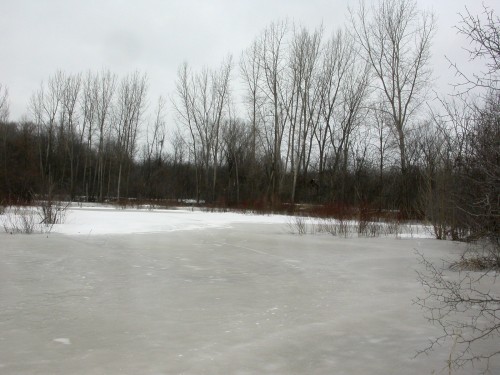 This apparent skating rink is the enormous ‘new’ single back pond, as viewed from the location of net H1. The flooding is so extensive that the multiple smaller ponds in this part of the property have all been joined, with an apparent depth of at least 30 cm in even the shallowest spots. (Photo by Marcel Gahbauer)-
This apparent skating rink is the enormous ‘new’ single back pond, as viewed from the location of net H1. The flooding is so extensive that the multiple smaller ponds in this part of the property have all been joined, with an apparent depth of at least 30 cm in even the shallowest spots. (Photo by Marcel Gahbauer)- Among the 10 redpolls banded this week was the interesting individual above. An orange, rather than red cap, a shorter bill than most others, and a generally paler appearance – yet on balance, still a Common Redpoll, rather than a Hoary Redpoll. (Photo by Marcel Gahbauer)-
Among the 10 redpolls banded this week was the interesting individual above. An orange, rather than red cap, a shorter bill than most others, and a generally paler appearance – yet on balance, still a Common Redpoll, rather than a Hoary Redpoll. (Photo by Marcel Gahbauer)- Let nobody say that we don’t treat our feathered visitors well! This Black-capped Chickadee, originally banded at MBO on October 28, 2005, was recaptured this week. An early season fly was buzzing about inside, and on a whim we held the chickadee nearby; it didn’t hesitate long before snapping up the fly. (Photo by Marcel Gahbauer)
Let nobody say that we don’t treat our feathered visitors well! This Black-capped Chickadee, originally banded at MBO on October 28, 2005, was recaptured this week. An early season fly was buzzing about inside, and on a whim we held the chickadee nearby; it didn’t hesitate long before snapping up the fly. (Photo by Marcel Gahbauer)